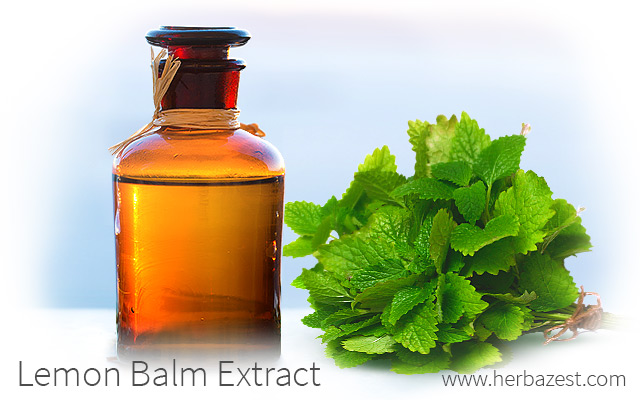Preparing a lemon balm extract at home is not only easy, but also an affordable way to preserve this herb's lemony-mint scent and gain its medicinal benefits. Learn more about this preparation, from how to make the extract of lemon balm to the many benefits of using it.
An extract is a concentrated liquid made by extracting the constituents of an herb in a non-alcoholic solution (e.g., water, glycerin, vinegar). Though the terms extract and tincture are often used interchangeably, the main difference is the carrier element used to acquire the medicinal properties of the herb.
How to Make Lemon Balm Extract
The process to make lemon balm extract is very similar to that of lemon balm oil and only differs in the type of carrier substance used for the process, which in this case will be glycerin.
Glycerin is a water-soluble, colorless, odorless, viscous liquid with a high boiling point, which makes it a great carrier substance for the preparation of herbal extracts. It has a sweet taste (being 60% sucrose) but a low glycemic index. It is compatible with many other substances, safe to handle, and virtually non-toxic to human health and to the environment. According to its origin, glycerin can be animal based, plant based, or synthetic.
This is an extremely safe method of obtaining lemon balm's benefits, since there's no risk of exposure to any toxic agents.
HERBAL EXTRACTS OBTAINED USING GLYCERIN ARE ALSO CALLED GLYCERITES.
To make the extract of lemon balm, you will need:
- Fresh or dried lemon balm leaves
- Boiling water
- Vegetable glycerin
- A dry, clean glass container
Step by step process:
- Place the lemon balm leaves in a glass container. If you are using dried leaves, fill it around two-thirds full. With fresh leaves, you will need to fill it within a few inches of the top.
- Pour half a cup of boiling water over the leaves.
- Add the vegetable glycerin up to few inches from the top and cover the glass container with a lid.
- Place the container in a crockpot with a towel at the bottom to prevent the glass from breaking. Fill the crockpot with water and turn it on at minimum heat. In order to maintain the low temperature, it is better not to cover the crockpot.
- Take off the lid of the container once a day and stir the preparation to allow the lemon balm leaves to release their compounds.
- As it evaporates, keep adding water to maintain the same level for around three days.
- On the third day, remove the glass container from the crockpot and strain the content in a bowl using a cloth. Wring the cloth very well to extract the last drop.
- Transfer to a dark glass container and store it in a cool, dark cabinet. Under the right conditions, this preparation will a have a shelf life of two to three years. However, in order to reduce the risk of bacterial contamination, the lemon balm extract can be stored in the fridge.
An easier, alternative method of extracting lemon balm's benefits consists of just covering the herbal material with a mixture of water and at least 55% of glycerin, combining very well, putting on a lid, and letting it macerate in a dark, cool place for a period of four to six weeks. Then strain and store as described above.
Lemon Balm Extract Benefits
The extract of lemon balm is ideal for children, since it has no alcohol. This way of consumption is great for calming the nerves and relieving insomnia. The optimal dosage is one third to half a teaspoon (30 - 60 drops) three times a day, diluted in water, juice, or a tea, preferably between meals and before bedtime.
Although not as strongly concentrated as a lemon balm tincture, this preparation preserves the lemony taste of lemon balm and can also be used to flavor baked goods and drinks.
As you can see, lemon balm extract is a very useful preparation that only requires time and patience; it can be safely made at home without any complicated equipment and will let you enjoy all the wonderful benefits of lemon balm.
Sources
- BOTEC Analysis Corporation, Methods for Producing and Testing Extracts and Infusions
- The Soap and Detergent Association, Glycerine: an overview, 1990




